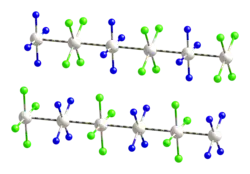
In chemistry and materials science, linear chain compounds are materials composed of one-dimensional arrays of metal-metal bonded molecules or ions. Such materials exhibit anisotropic electrical conductivity.[1][2]
Examples
Most examples are composed of square planar complexes. Thus, upon crystallization, molecules of Rh(acac)(CO)2 stack with Rh···Rh distances of about 326 pm.[3] Classic examples include Krogmann's salt and Magnus's green salt. Another example is the partially oxidized derivatives of [Pt(oxalate)2]2−. The otherwise ordinary complex IrBr(CO)3 gives an electrically conductive derivative upon oxidation, e.g., with bromine to give IrBr1+x(CO)3−x, where x ~0.05.[2][4] Related chlorides have the formulae IrCl1+x(CO)3 and K0.6Ir(CO)2Cl2·½H2O.[5]
In contrast to linear chain compounds, extended metal atom chains (EMACs) are molecules or ions that consist of a finite, often short, linear strings of metal atoms, surrounded by organic ligands.[6]


One group of platinum chains is based on alternating cations and anions of [Pt(CNR)4]2+ (R = iPr, c-C12H23, p-(C2H5)C6H4) and [Pt(CN)4]2−.[1] These may be able to be used as vapochromic sensor materials, or materials which change color when exposed to different vapors.[8][9][10]
Linear chains of Pd-Pd bonds protected by a "π-electron sheath" are known.[1][11]
Not only do these olefin-stabilized metal chains constitute a significant contribution to the field of organometallic chemistry, both the complex's metal atom structures and the olefin ligands themselves can conduct a current.[1][12]
Methodology
Some linear chain compounds are produced or fabricated by electrocrystallization. The technique is used to obtain single crystals of low-dimensional electrical conductors.[13]
See also
References
- 1 2 3 4 Bera, J. K.; Dunbar, K. R. (2002). "Chain Compounds Based on Transition Metal Backbones: New Life for an Old Topic". Angew. Chem. Int. Ed. 41 (23): 4453–4457. doi:10.1002/1521-3773(20021202)41:23<4453::AID-ANIE4453>3.0.CO;2-1. PMID 12458505.
- 1 2 Miller, Joel S. (1982). Miller, Joel S (ed.). Extended Linear Chain Compounds. Springer-Verlag. doi:10.1007/978-1-4613-3249-7. ISBN 978-1-4613-3251-0.
- ↑ Huq, Fazlul; Skapski, Andrzej C. (1974). "Refinement of the crystal structure of acetylacetonatodicarbonylrhodium(I)". J. Cryst. Mol. Struct. 4 (6): 411–418. doi:10.1007/BF01220097. S2CID 96977904.
- ↑ Tsuji, Yuta; Hoffmann, Roald; Miller, Joel S. (2016). "Revisiting Ir(CO)3Cl". Polyhedron. 103: 141–149. doi:10.1016/j.poly.2015.09.050.
- ↑ Ginsberg, A. P.; Koepke, J. W.; Sprinkle, C. R. (2007). Linear-Chain Iridium Carbonyl Halides. Inorganic Syntheses. Vol. 19. pp. 18–22. doi:10.1002/9780470132500.ch5. ISBN 9780470132500.
- ↑ F. Albert Cotton, Carlos A. Murillo, Richard A. Walton (eds.), Multiple Bonds Between Metal Atoms, 3rd edition, Springer (2005)
- ↑ Hua, Shao-An; Liu, Isiah Po-Chun; Hasanov, Hasan; Huang, Gin-Chen; Ismayilov, Rayyat Huseyn; Chiu, Chien-Lan; Yeh, Chen-Yu; Lee, Gene-Hsiang; Peng, Shie-Ming (2010). "Probing the electronic communication of linear heptanickel and nonanickel string complexes by utilizing two redox-active [Ni2(napy)4]3+ moieties" (PDF). Dalton Transactions. 39 (16): 3890–6. doi:10.1039/b923125k. PMID 20372713.
- ↑ Grate, J. W.; Moore, L. K.; Janzen, D. E.; Veltkamp, D. J.; Kaganove, S.; Drew, S. M.; Mann, K. R. (2002). "Steplike Response Behavior of a New Vapochromic Platinum Complex Observed with Simultaneous Acoustic Wave Sensor and Optical Reflectance Measurements". Chem. Mater. 14 (3): 1058–1066. doi:10.1021/cm0104506.
- ↑ Buss, C.E.; Mann, K.R. (2002). "Synthesis and Characterization of Pt(CN\-p\-(C2H5)C6H4)2(CN)2, a Crystalline Vapoluminescent Compound That Detects Vapor-Phase Aromatic Hydrocarbons". J. Am. Chem. Soc. 124 (6): 1031–1039. doi:10.1021/ja011986v. PMID 11829612.
- ↑ Buss, C.E.; Anderson, C.E.; Pomije, M. K.; Lutz, C. M.; Britton, D.; Mann, K. R. (1998). "Structural Investigations of Vapochromic Behavior. X-ray Single-Crystal and Powder Diffraction Studies of [Pt(CN\-iso\-C3H7)4][M(CN)4] for M = Pt or Pd". J. Am. Chem. Soc. 120 (31): 7783–7790. doi:10.1021/ja981218c.
- ↑ Mino, Y; Mochizuki, E; Kai, Y; Kurosawa, H (2001). "Reversible Interconversion between Dinuclear Sandwich and Half-Sandwich Complexes: Unique Dynamic Behavior of a Pd-Pd Moiety Surrounded by an sp2-Carbon Framework". J. Am. Chem. Soc. 123 (28): 6927–6928. doi:10.1021/ja010027y.
- ↑ Murahashi, T; Nagai, Okuno, T; Matsutani, T; Kurosawa, H. (2000). "Synthesis and ligand substitution reactions of a homoleptic acetonitrile dipalladium(I) complex". Chem. Commun. (17): 1689–1690. doi:10.1039/b004726k.
{{cite journal}}: CS1 maint: multiple names: authors list (link) - ↑ Williams, Jack M (1989). "Highly Conducting and Superconducting Synthetic Metals". Inorganic Syntheses. Inorganic Syntheses. Vol. 26. pp. 386–394. doi:10.1002/9780470132579.ch70. ISBN 978-0-470-13257-9.